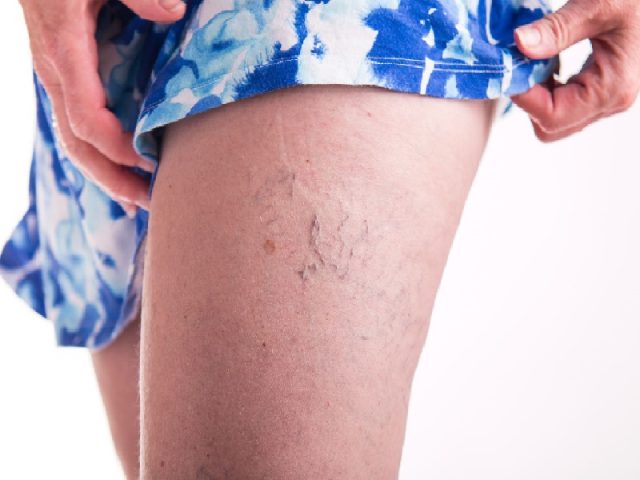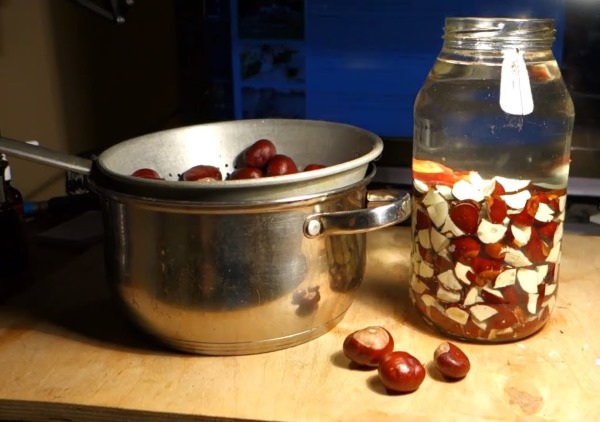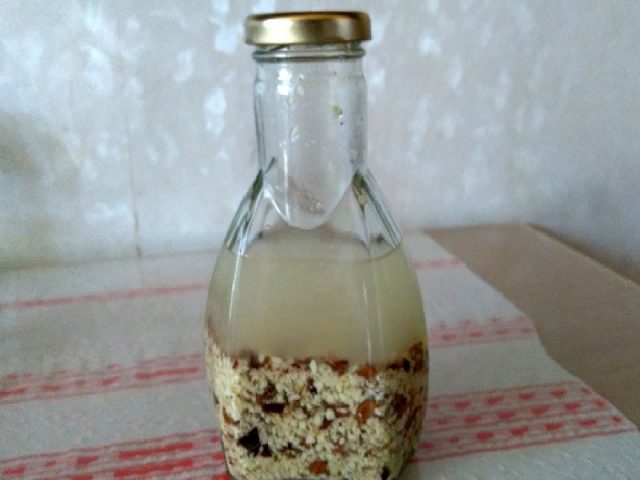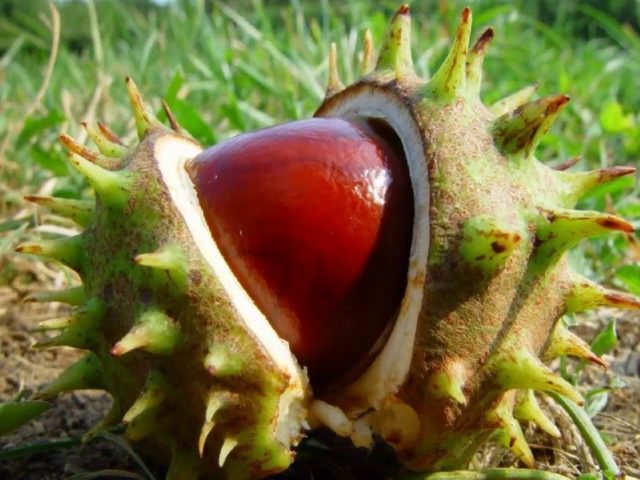Content
The benefits and harms of horse chestnut tincture is of interest to modern science. The effective use of the fruit of the tree in alternative medicine has piqued the curiosity of scientists. Today, chestnut seeds are effectively used for the preparation of medicines and are prescribed for therapeutic purposes for the treatment of pathologies of various body systems.
The benefits and harms of chestnut tincture
The ability of the horse chestnut to have a positive effect on the body's systems is due to its structure. The seeds of the tree contain a high concentration of saponins (escin), tannins, vitamin composition (C, K, B1, A), pectins, glycosides, and fraxin. All parts of the plant are valuable. The flowers are also rich in rutin and pectin.
The medicinal properties of horse chestnut are used for varicose veins in conservative medicine. On the basis of the plant fruit extract, pharmacological agents are prepared that restore venous vessels, tonic, eliminate inflammatory processes. Horse chestnut in dosage forms is widely used by vascular surgeons to obtain a venoprotective, anti-thrombotic action that improves blood circulation in small veins.
For many centuries, alternative medicine has been drawing on the invaluable properties of the horse chestnut, as it can:
- tone the veins, accelerate the movement of blood in the bloodstream;
- prevent the formation of blood clots, make the blood less thick and viscous;
- eliminate pain;
- regenerate tissue in the foci;
- have a bactericidal effect;
- have a diuretic effect, relieve swelling;
- eliminate fever, have a diaphoretic effect;
- stop the development of atherosclerosis, remove "bad" cholesterol, dissolve cholesterol plugs;
- to have an antioxidant effect, to purify from toxic compounds;
- reduce capillary permeability, stop bleeding;
- normalize the acidity of gastric juice, improve digestion;
- have an astringent effect;
- lower blood pressure;
- get rid of purulent foci, accelerate the process of tissue regeneration in case of burns, frostbite.
Horse chestnut tincture and other dosage forms have been effectively used since the 18th century for the treatment of malaria, fevers, and dysentery. They were used to cure varicose veins and gout. Chestnut bark recommended the elimination of diarrhea, hemorrhoids, gynecological diseases by the German doctor Hufeland. Kneipp used the seeds of the plant for the treatment of veins, the digestive system, and diseases of the musculoskeletal system. Horse chestnut tincture in official medicine began to appear in 1866 and had a wide range of effects.
Today, pharmaceutical companies produce medicines in the form of tinctures, ointments, drops, tablets, injections, suppositories, based on bark, leaves, inflorescences, seeds.Horse chestnut homeopathic remedies are prescribed for the treatment of trophic ulcers, catarrh of the nasopharynx, hemorrhoids.
What does chestnut tincture help with?
The correct use of horse chestnut tincture makes it possible to feel the effect in various pathologies.
The remedy is effective for the following vascular diseases:
- varicose veins;
- venostasis;
- thrombophlebitis;
- vascular sclerosis;
- blood viscosity;
- the likelihood of blood clots.
Applicable for these joint conditions:
- inflammatory processes;
- soreness and swelling;
- rheumatism;
- arthritis;
- arthrosis.
Helps with such pathologies of the heart and blood vessels:
- high blood viscosity;
- high levels of "bad" cholesterol;
- angina pectoris;
- the likelihood of a heart attack;
- arterial hypertension.
Also, the compositions are effective in diseases of the digestive system, hemorrhoids, gynecological diseases.
The benefits of horse chestnut tincture have been noted in the treatment of lesions with Koch's bacillus, cancers, and leukemia.
How to make horse chestnut tincture
There are many ways to prepare horse chestnut tincture. Recipes may vary depending on the intended use of the product. Chestnut tincture with vodka and alcohol is predominantly popular; mixes with additional inclusions are also allowed.
Horse chestnut tincture on vodka
Horse chestnut drenched with vodka does not process the main component, therefore, all nutrients are preserved in full. The recipe for the preparation of the dosage form is not difficult, and the result is a composition that is used internally and externally.
For cooking you will need:
- plant seeds - 50 g;
- vodka - half a liter.
Algorithm of actions:
- All fruits are crushed without removing the brown crust - they are put in a glass container.
- Vodka is poured into the chestnut mass.
- Kept in a dark room for about two weeks, shaken occasionally.
- The treatment course is recommended to be maintained for 21 days, inside (three times a day).
Chestnut tincture on alcohol
Having prepared the medicine with alcohol, there is no doubt that the medicinal properties will remain for a long time. For cooking you will need:
- seeds - 10 pieces;
- alcohol 250 ml.
Algorithm of actions:
- Whole chestnut seeds are taken, placed in a glass container.
- Pour in alcohol.
- Set aside in a cool dark place.
- Withstand 14 days.
- Poured into a dark glass container.
The tincture is most often used externally, but sometimes it is indicated for internal use. For this, 20 drops of the finished product are diluted in 30 ml of water, mixed and taken half an hour before meals. The course of therapy is designed for 3 weeks of daily use three times a day.
Alcohol tincture of chestnut with burdock juice
For childhood rheumatism, a tincture with burdock extract is prepared for grinding. For cooking you will need:
- plant seeds - 1 cup:
- burdock juice - 1 glass;
- alcohol (40%) - 1 glass.
Algorithm of actions:
- Chestnuts are folded into a glass container and burdock juice is added.
- Pour in alcohol.
- Kept for 3 months in a cool, dark place.
In addition to eliminating rheumatic pains, the fluid relieves swelling, improves the function of the myocardium and blood vessels. She is able to cope with gastritis, liver disease, gout.
How to take chestnut tincture
Horse chestnut tincture is used depending on the problem. It can be used internally and externally.Also, good results and quick action can be achieved by simultaneously applying the composition to the foci and ingestion.
The use of chestnut tincture on alcohol for joints
Joint pathologies cause pain, hyperemic areas and edema appear. Some diseases cannot be completely healed, but you can eliminate the annoying symptoms or significantly smooth them out without resorting to medications.
Tincture of chestnuts with vodka for joints is prepared as follows:
- Cut fresh chestnut seeds into 4 pieces.
- Pour in alcohol so that all the fruits are covered.
- Withstand 3 days in the sun.
- Insist 40 days without access to light, in the cool.
The result will not be long in coming, if you rub the joints 2-3 times a day, it is also recommended to apply compresses for 2-3 hours. Internal use can be added to external use - 35 drops each, before meals.
Chestnut tincture for varicose veins
The use of tincture reduces the permeability of the walls of blood vessels, thins the blood, and prevents the development of blood clots. The main direction in therapy is varicose veins, but it is effectively used for such pathologies:
- venostasis;
- thrombophlebitis;
- vascular sclerotic changes;
- retinal vein thrombosis.
To get the effect of a prescription horse chestnut tincture for varicose veins, you must use the remedy correctly. A compress is moistened in the tincture, applied at night to painful places. Simple manipulation quickly relieves pain. The duration of therapy is a week, a break is 3 months. As a result, it is possible to get rid of the blue skin tone, pain, swelling.
Also, compresses are recommended to be used simultaneously with the internal use of horse chestnut tincture.
To relieve tension from the legs, smooth out the feeling of heaviness, improve the condition of the veins, it is recommended to feel the medicinal properties of horse chestnut with varicose veins, using a tincture of 30 drops before each meal, daily. In parallel, it will be useful to apply the composition to the affected areas.
With regular use, they notice an improvement in blood circulation, the condition of the venous walls.
Chestnut tincture on alcohol for thrombophlebitis
With thrombophlebitis, the concentration of blood is disturbed, it becomes viscous and thick. Subsequently, this phenomenon leads to the formation of blood clots. Tincture for the treatment of thrombophlebitis is prepared as follows:
- The seeds are crushed in any way possible.
- The gruel is transferred to a glass container.
- For 300 g of substance, add 1 liter of vodka.
- Withstand a week without access to light.
All non-traditional methods of treatment have a cumulative effect, respectively, the result from the use of the remedy will be more reliable if the tincture is used regularly.
The use of chestnut tincture on vodka for gastrointestinal diseases
The structure of the horse chestnut contains a lot of nutrients that help improve digestion, stop pathological processes. It relieves the symptoms of gastritis, cholecystitis better than medications, and adjusts the bowel function.
Horse chestnut tincture for diseases of the cardiovascular system
Making the walls of the capillaries stronger, reducing the concentration of blood, reducing the indicators of "bad" cholesterol, the tincture improves the function of the heart, relieves angina pectoris. It is an excellent prophylactic agent that does not allow a heart attack, hypertension.
Precautions
The seeds of the plant are saturated with potent ingredients. Mostly this was the reason that the chestnut was excluded from food. The fruits are unsuitable for food, as they are excessively bitter and knit, capable of provoking intoxication. Ingestion of the fruit is possible only in the form of decoctions, tinctures.
When using horse chestnut tincture for the first time, it is important to closely monitor changes in sensations, local reactions to a substance.
Passing a course of therapy with this remedy against the background of concomitant pathologies may well provoke complications. Unconventional methods of treatment often suppress or enhance the effect of the active substance of pharmaceutical drugs.
Contraindications to horse chestnut infusion
Horse chestnut tincture at home, prepared on the basis of alcohol or vodka, as well as industrial preparations with an identical composition, have a number of contraindications that should be taken into account so as not to aggravate the existing situation. The tool is unacceptable in the following cases:
- period of bearing the child;
- lactation;
- constipation of an atonic nature;
- low pressure;
- gastritis in acute hypocidal form;
- poor blood clotting, decreased prothrombin;
- children under the age of 16;
- alcoholism;
- profuse bleeding during menstruation.
People taking horse chestnut tincture for a long time should notify the attending physician about this, and also periodically conduct a blood test for prothrombin. The medicinal properties of horse chestnut tincture are varied and contraindications are not comparable, but they should be taken into account and, if necessary, the selected therapeutic tactics should be canceled.
Terms and conditions of storage
Horse chestnut tincture is prepared with alcohol or vodka, which significantly extends the shelf life. If the product is stored in cool dry conditions, then there are no restrictions on the use of the medicinal product. In the case when the sun's rays enter the room and the temperature regime is not observed, the tincture should be consumed within two years.
Reviews of horse chestnut tincture
Conclusion
The benefits and harms of chestnut tincture are incomparable, but they require a careful approach to treatment and health. Distant ancestors knew about the effectiveness of the plant, but contraindications cannot be ignored. The best decision before starting a course of treatment is to consult a doctor. Deviations from the norm in the general condition are a reason to consult a specialist.















